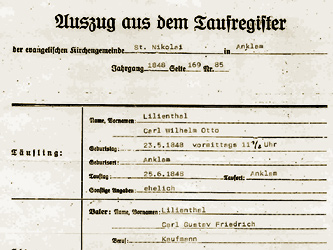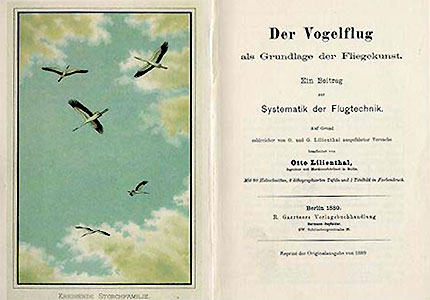| |
Eight children were born to Gustav Lilienthal, a cloth trader in Anklam, Norht-East Germany, and his wife Caroline. Otto, their eldest, was born on 23 May 1848. But Only Otto and two other children grew up : his brother Gustav, one year younger than Otto, and his sister Marie, 8 years younger. (by clicking on the picture below, you this act in its entirety) |
| |
|
 |
The financial situation of the family became more and more difficult from year to year, so they decided to emigrate to America, but then the father died unexpectedly in 1861, when Otto Lilienthal was only 13 years old.
The family remainde in Germany, and Caroline Lilienthal’s first priority to give her children a good education. From 1856 to 1864, Otto studies at Grammar school in Anklam. His subjects included the study of birds and his mathematics teacher was Gustav Spörer (an important German astronomer).
Then he joined the Regional Technical School in Potsdam (1864 - 1866) and to follow after practical training (Mechanical Engineering) at the Schwartzkopf Company in Berlin (1866 - 1867)
By a decision of his uncle and guardian, Otto study mechanical engineering in Berlin at the new founded Royal Technical Academy (1867 - 1870).
In 1867, he began his flight experiments. Experiences interrupted during 1 year (1870-1871) when he made a voluntary one year military service as a fusilier to serve in the Franco-Prussian War.
|
| |
Then he was employed in the Weber Company (mechanical engineering firm), Berlin. In 1873, with his brother, Gustav, he became a member of the Aeronautical Society of Great Britain. and gave his first public lecture in Germany on the theory of flight of birds.
In 1877, he filed a patent on a machine used in mining. This is the first of 25 patents Lilienthal, with 4 on the flying machine. It is June 11, 1878 he married Agnes Fischer, daughter of a minor. The following year she gave birth to the first of their four children, a son, they called Otto. |
| |
He created his own mechanical engineering company for boilers and steam engines in Berlin. On the social level, he is also a precursor because in 1890 he creates for his workers a 25% profit of his company.
In 1886, he joined the club "Deutscher Verein zur Förderung der Luftschiffahrt" (German Club for the promotion of airship navigation) in Berlin. In the year 1874 and 1888, Otto and Gustav experimented and researched systematically the forces of air on artificial wings and on the characteristics of natural wind using models and kites.
It is from this period that Otto made his first flying experiments whose results on the physical basics of human flight are published in his book :
Der Vogelflug als Grundlage der Fliegekunst ("Birdflight as the basis of aviation") published in 1889 and English translation 1911.
But on 9 August, 1896, Lilienthal's glider lost its lift and he fell from a height of 17 m (56 ft). He died of a broken spine the following day in Berlin, saying, "Kleine Opfer müssen gebracht werden!" ("Small sacrifices must be made!"). He was buried at Lankwitz Cemetery in Berlin.
An analysis of the crash in "Aviation, Space, and Environmental Medicine x Vol. 79, No. 10 x October 2008" (in english) : link herei
|
|
| |
|
Surprisingly, one of his inventions survives him to this day all over the world: the wood blocks construction set. Certain "Ankersteinbaukasten" models have not change in a century! |
| |

 |


